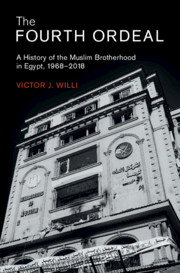Book contents
- The Fourth Ordeal
- Cambridge Middle East Studies
- The Fourth Ordeal
- Copyright page
- Dedication
- Contents
- Plates, Figures and Tables
- Acknowledgements
- Note on Transliterations and References
- Note on Sources
- Chronology of Events
- Dramatis Personae
- Abbreviations
- Prologue
- Introduction
- 1 The Society of the Muslim Brothers
- 2 The Second Founding (1968–1981)
- 3 The Rise of the Vanguard (1981–1991)
- 4 Brotherhood Incorporated (1991–2001)
- 5 Struggle for Leadership (2001–2011)
- 6 Revolution, Rise and Fall (2011–2013)
- 7 The Beginning of the Fourth Ordeal (2013–2018)
- Conclusion
- Epilogue
- Glossary
- Bibliography
- Index
- Books in the Series
- Plate Section
- Plate Section
4 - Brotherhood Incorporated (1991–2001)
Published online by Cambridge University Press: 02 February 2021
- The Fourth Ordeal
- Cambridge Middle East Studies
- The Fourth Ordeal
- Copyright page
- Dedication
- Contents
- Plates, Figures and Tables
- Acknowledgements
- Note on Transliterations and References
- Note on Sources
- Chronology of Events
- Dramatis Personae
- Abbreviations
- Prologue
- Introduction
- 1 The Society of the Muslim Brothers
- 2 The Second Founding (1968–1981)
- 3 The Rise of the Vanguard (1981–1991)
- 4 Brotherhood Incorporated (1991–2001)
- 5 Struggle for Leadership (2001–2011)
- 6 Revolution, Rise and Fall (2011–2013)
- 7 The Beginning of the Fourth Ordeal (2013–2018)
- Conclusion
- Epilogue
- Glossary
- Bibliography
- Index
- Books in the Series
- Plate Section
- Plate Section
Summary
This chapter focuses on the major socio-economic and ideological developments having shaped the Brotherhood’s evolution during the nineties. Picking up the story of Khairat al-Shatir from Chapter 2, the narrative centres on the Brotherhood’s internal transformations during the second decade of Mubarak’s rule. Against larger transformations taking place within Egypt’s political economy, caused by the impact of neoliberal policies, the chapter shows how the deepening disagreements between the followers of ‘Omar al-Tilmisani on the one hand, and an increasingly assertive group of business-minded vanguardists on the other, was progressively tilted in favour of the latter group. The chapter ends by recounting how, against the backdrop of an intensifying wave of regime repression, the Brotherhood was pushed back into the underground – all the while the debates about the Society’s role in Egyptian politics continued to challenge it internally. Based on Oral History interviews with eyewitnesses of the events in question, memoires and available online material, original texts published by the Brotherhood and a reading of the available literature, the chapter expose how an increasingly acrimonious internal conflict among the Brothers gradually morphed into the formalization of distinct political coalitions, each of which advocated for conflicting visions of the Brotherhood’s political future.
Keywords
- Type
- Chapter
- Information
- The Fourth OrdealA History of the Muslim Brotherhood in Egypt, 1968–2018, pp. 141 - 178Publisher: Cambridge University PressPrint publication year: 2021

